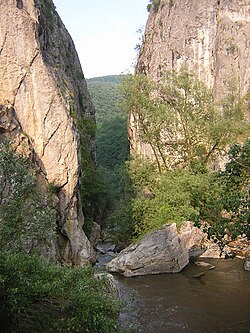

This article includes a list of general references, but it lacks sufficient corresponding inline citations. Please help to improve this article by introducing more precise citations. (December 2016) (Learn how and when to remove this message)
|
| Jerma | |
|---|---|

The Erma Gorge, Bulgaria
| |
| Native name |
|
| Location | |
| Country | Serbia, Bulgaria |
| Physical characteristics | |
| Source | |
| • location | near Lake Vlasina, Serbia |
| Mouth | |
• location | Nišava near Pirot, Serbia |
• coordinates | 43°4′0″N 22°41′7″E / 43.06667°N 22.68528°E / 43.06667; 22.68528 |
| Length | 72 km (45 mi)[1] |
| Basin features | |
| Progression | Nišava→ South Morava→ Great Morava→ Danube→ Black Sea |
The Jerma (Serbian Cyrillic: Јерма) or Erma (Bulgarian: Ерма) is a river in southeastern Serbia and western Bulgaria. It is notable for passing the Bulgarian-Serbian border twice.
The Jerma originates in the undeveloped and sparsely populated area of Krajište, in the southeastern corner of Serbia. Starting from the area between the artificial Lake Vlasina and the Bulgarian border, it flows to the northwest on the eastern slopes of the Gramada mountain, passing through the village of Klisura, after which it enters the area of Знепоље (Znepolje, Bulgarian: Знеполе, Znepole), an arid region stretching over the border into Bulgaria. This is where the Jerma crosses the border for the first time, at the border crossing of Strezimirovci.


Continuing through the Bulgarian valley of Znepole curving around the eastern side of the Ruy mountain, the river, now called the Erma, is also known as Transka reka after the town of Tran, a regional centre of this area. The Erma passes close to the villages of Glavanovtsi and Turokovtsi, where it turns north, running through Tran. After Tran, the Erma cuts the famous Tran Gorge. After the gorge, the Erma flows through the Bulgarian part of the village of Petačinci. The Erma receives its major tributary, the Yablanitsa, right before it re-enters Serbia after a 26 kilometres (16 mi) travel through Bulgaria. The river crosses the border for the second time about 1 kilometre (0.62 mi) after Petačinci.
The Jerma continues to flow generally to the north, passing next to the village of Iskrovci and the spa of Zvonačka Banja. Proceeding between the mountains of Greben and Vlaška planina, it runs close to the villages of Trnsko-Odorovce and Vlasi, and the monasteries of Sveti Jovan, Sveti Nikolaj and Sveta Bogorodica, before it empties into the Nišava River, southeast of Pirot after a total of 48 km (30 mi) in Serbia (thus belonging to the Black Sea drainage area). In this last section, the Jerma flows through the Sukovo coal basin, named after the village Sukovo, which is not on the banks of the Jerma itself, but slightly to the west. Despite the hard coal's high quality (7,000 cal), the coal mine near Pirot was shut down and coal is not being extracted anymore. In this final section, the Jerma is also known as Sukovska reka (Cyrillic: Суковска река; "river of Sukovo").
During the January 2021 floods, the Jerma flooded the road in its valley and overflooded the riverbed of the Nišava. This caused the spilling of the Nišava, which flooded parts of Bela Palanka.[2]
|
| |
|---|---|
| National parks |
|
| Nature reserves |
|
| Nature parks |
|
| Landscapes of outstanding features |
|
| Natural monuments (selection) |
|